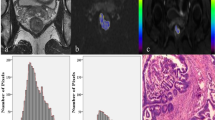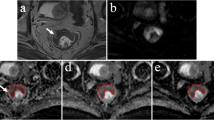Abstract
Purpose
To compare tumor detectability and conspicuity of standard b = 1000 s/mm2 (b1000) versus ultrahigh b = 2000 s/mm2 (b2000) diffusion-weighted imaging (DWI) in rectal cancer.
Methods
Fifty-five patients for a total of 81 3T DWI-MR scans were retrospectively evaluated by two differently experienced readers. A comparison between b1000 and b2000 for tumor detectability and conspicuity was performed. The conspicuity was qualitatively and quantitatively assessed by using three-point scale and whole tumor volume manual delineation, respectively. Receiver-operating characteristic curve (ROC) with area under the curve (AUC) analysis provided diagnostic accuracy in tumor detectability of restaging MR scans. Qualitative scores and quantitative features including mean signal intensity, variance, 10th percentile and 90th percentile, were compared using the Wilcoxon test. Interobserver agreement (IOA) for qualitative and quantitative data was calculated using Cohen’s Kappa and intraclass correlation coefficient (ICC) respectively.
Results
Diagnostic accuracy was comparable between b1000 and b2000 for both readers (p > 0.05). Overall quality scores were significantly better for b2000 than b1000 (2.29 vs 1.65 Reader 1, p = 0.01; 2.18 vs 1.69 Reader 2, p = 0.04). IOA was equally good for both b values (k = 0.86 b1000, k = 0.86 b2000). Quantitative analysis revealed more uniform signal (measured in variance) of b2000 in both healthy surrounding tissue (p < 0.05) and tumor (p < 0.05), with less outliers (measured using 10th and 90th percentile). Additionally, b2000 offered lower mean signal intensity in tissue sorrounding the tumor (p < 0.05). Finally, ICC improved from 0.92 (b1000) to 0.97 (b2000).
Conclusion
Ultrahigh b value (b2000) may improve rectal cancer conspicuity and introbserver agreement maintaining comparable diagnostic accuracy to standard b1000.






Similar content being viewed by others
References
Beets-Tan, R.G.H., et al., Magnetic resonance imaging for clinical management of rectal cancer: Updated recommendations from the 2016 European Society of Gastrointestinal and Abdominal Radiology (ESGAR) consensus meeting. Eur Radiol, 2018. 28(4): p. 1465-1475.
Delli Pizzi, A., et al., Rectal cancer MRI: protocols, signs and future perspectives radiologists should consider in everyday clinical practice. Insights Imaging, 2018. 9(4): p. 405-412.
Maas, M., et al., Wait-and-see policy for clinical complete responders after chemoradiation for rectal cancer. J Clin Oncol, 2011. 29(35): p. 4633-40.
van der Paardt, M.P., et al., Patients who undergo preoperative chemoradiotherapy for locally advanced rectal cancer restaged by using diagnostic MR imaging: a systematic review and meta-analysis. Radiology, 2013. 269(1): p. 101-12.
Lambregts, D.M.J., et al., A Pattern-Based Approach Combining Tumor Morphology on MRI With Distinct Signal Patterns on Diffusion-Weighted Imaging to Assess Response of Rectal Tumors After Chemoradiotherapy. Dis Colon Rectum, 2018. 61(3): p. 328-337.
Delli Pizzi, A., et al., Performance of diffusion-weighted magnetic resonance imaging at 3.0T for early assessment of tumor response in locally advanced rectal cancer treated with preoperative chemoradiation therapy. Abdom Radiol (NY), 2018. 43(9): p. 2221-2230.
Lambregts, D.M., et al., Diffusion-weighted MRI to assess response to chemoradiotherapy in rectal cancer: main interpretation pitfalls and their use for teaching. Eur Radiol, 2017.
Tamada, T., et al., High b value (2,000 s/mm2) diffusion-weighted magnetic resonance imaging in prostate cancer at 3 Tesla: comparison with 1,000 s/mm2 for tumor conspicuity and discrimination of aggressiveness. PLoS One, 2014. 9(5): p. e96619.
Fukukura, Y., et al., Computed diffusion-weighted MR imaging for visualization of pancreatic adenocarcinoma: Comparison with acquired diffusion-weighted imaging. Eur J Radiol, 2017. 95: p. 39-45.
Ueno, Y., et al., Ultra-high b-value diffusion-weighted MRI for the detection of prostate cancer with 3-T MRI. J Magn Reson Imaging, 2013. 38(1): p. 154-60.
Moribata, Y., et al., Feasibility of Computed Diffusion Weighted Imaging and Optimization of b-value in Cervical Cancer. Magn Reson Med Sci, 2017. 16(1): p. 66-72.
Hausmann, D., et al., Image Quality Assessment of 2D versus 3D T2WI and Evaluation of Ultra-high b-Value (b = 2,000 mm/s(2)) DWI for Response Assessment in Rectal Cancer. Anticancer Res, 2018. 38(2): p. 969-978.
Tang, L. and X.J. Zhou, Diffusion MRI of cancer: From low to high b-values. J Magn Reson Imaging, 2019. 49(1): p. 23-40.
Xie, H. and G. Wu, Application of Diffusion Kurtosis Imaging and Histogram Analysis for Assessing Preoperative Stages of Rectal Cancer. Gastroenterol Res Pract, 2018. 2018: p. 9786932.
Mandard, A.M., et al., Pathologic assessment of tumor regression after preoperative chemoradiotherapy of esophageal carcinoma. Clinicopathologic correlations. Cancer, 1994. 73(11): p. 2680-6.
Lambregts, D.M., et al., Long-term follow-up features on rectal MRI during a wait-and-see approach after a clinical complete response in patients with rectal cancer treated with chemoradiotherapy. Dis Colon Rectum, 2011. 54(12): p. 1521-8.
Rosenkrantz, A.B., et al., Diffusion-weighted imaging of the prostate: Comparison of b1000 and b2000 image sets for index lesion detection. J Magn Reson Imaging, 2013. 38(3): p. 694-700.
Ning, P., et al., The impact of computed high b-value images on the diagnostic accuracy of DWI for prostate cancer: A receiver operating characteristics analysis. Sci Rep, 2018. 8(1): p. 3409.
Goh, V., et al., Quantitative assessment of colorectal cancer tumor vascular parameters by using perfusion CT: influence of tumor region of interest. Radiology, 2008. 247(3): p. 726-32.
Lambregts, D.M., et al., Tumour ADC measurements in rectal cancer: effect of ROI methods on ADC values and interobserver variability. Eur Radiol, 2011. 21(12): p. 2567-74.
Blazic, I.M., G.B. Lilic, and M.M. Gajic, Quantitative Assessment of Rectal Cancer Response to Neoadjuvant Combined Chemotherapy and Radiation Therapy: Comparison of Three Methods of Positioning Region of Interest for ADC Measurements at Diffusion-weighted MR Imaging. Radiology, 2017. 282(2): p. 615.
Ohgiya, Y., et al., Diagnostic accuracy of ultra-high-b-value 3.0-T diffusion-weighted MR imaging for detection of prostate cancer. Clin Imaging, 2012. 36(5): p. 526-31.
Mazaheri, Y., et al., Model selection for high b-value diffusion-weighted MRI of the prostate. Magn Reson Imaging, 2018. 46: p. 21-27.
Martens, M.H., et al., Long-term Outcome of an Organ Preservation Program After Neoadjuvant Treatment for Rectal Cancer. J Natl Cancer Inst, 2016. 108(12).
Lambregts, D.M., et al., MRI and diffusion-weighted MRI to diagnose a local tumour regrowth during long-term follow-up of rectal cancer patients treated with organ preservation after chemoradiotherapy. Eur Radiol, 2016. 26(7): p. 2118-25.
Macchia, G., et al., Time to surgery and pathologic complete response after neoadjuvant chemoradiation in rectal cancer: A population study on 2094 patients. Clin Transl Radiat Oncol, 2017. 4: 8-14.
Yu, S.K., et al., Magnetic resonance imaging defined mucinous rectal carcinoma is an independent imaging biomarker for poor prognosis and poor response to preoperative chemoradiotherapy. Eur J Cancer, 2014. 50:920–927.
Sengul, N., et al., Effects of radiotherapy on different histopathological types of rectal carcinoma. Color Dis, 2006. 8:283–288
Acknowledgements
The authors thank Daniele Petrucci and Darien Calvo Garcia for their insightful contribution on the MR protocol settings and the acquisition of data; Paolo Raimondi for the surgical specimen and pathology showed in Fig. 4.
Funding
No grant support.
Author information
Authors and Affiliations
Contributions
All authors were involved in patient management and wrote and/or reviewed the report. Written consent to publication was obtained.
Corresponding author
Ethics declarations
Conflict of interest
All authors declare that they have no conflict of interest.
Ethical approval
All procedures performed in this study involving human participant were in accordance with the ethical standards of the institutional and/or national research committee and with the 1964 Helsinki declaration and its later amendments or comparable ethical standards.
Informed consent
Informed consent was obtained from the patients included in this study.
Additional information
Publisher's Note
Springer Nature remains neutral with regard to jurisdictional claims in published maps and institutional affiliations.
Rights and permissions
About this article
Cite this article
Delli Pizzi, A., Caposiena, D., Mastrodicasa, D. et al. Tumor detectability and conspicuity comparison of standard b1000 and ultrahigh b2000 diffusion-weighted imaging in rectal cancer. Abdom Radiol 44, 3595–3605 (2019). https://doi.org/10.1007/s00261-019-02177-y
Published:
Issue Date:
DOI: https://doi.org/10.1007/s00261-019-02177-y




